LG 43UV340C, 43UV340H, 49UV340C, 49UV340H, 75UV340C User Manual
...
OWNER’S MANUAL
Safety and Reference
LED TV*
* LG LED TVs are LCD TVs with LED backlighting.
Please read this manual carefully before operating your TV and retain it for future reference.
43UV340C |
49UV340C |
55UV340C |
65UV340C |
75UV340C |
43UV340H |
49UV340H |
55UV340H |
65UV340H |
|
*MFL69885532* |
www.lg.com |
P/NO : MFL69885532 (1705-REV00) |
Copyright © 2017 LG Electronics Inc. All Rights Reserved.
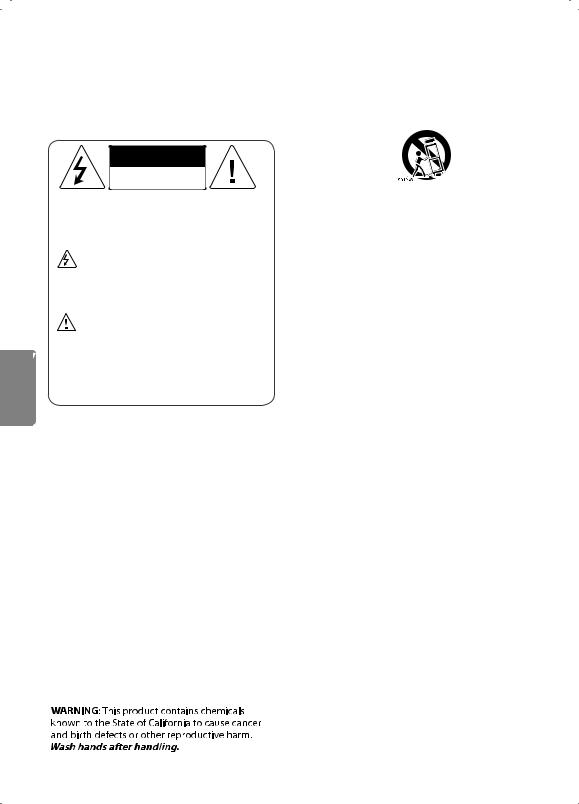
Warning! Important Safety instructions
Read these instructions. Keep these instructions. Heed all warnings. Follow all instructions.
CAUTION
RISKOFELECTRICSHOCK
DONOTOPEN
CAUTION : TO REDUCE THE RISK OF ELECTRIC SHOCK DO NOT REMOVE COVER (OR BACK). NO USER SERVICEABLE PARTS INSIDE. REFER TO QUALIFIED SERVICE PERSONNEL.
The symbol is intended to alert the user to the presence of uninsulated “dangerous
voltage” within the product’s enclosure that may be of sufficient magnitude to constitute a risk of electric shock to persons.
The symbol is intended to alert the user to the presence of important operating
and maintenance (servicing) instructions in the literature accompanying the device.
ENGLISH |
WARNING : TO REDUCE THE RISK OF FIRE |
|
|
|
AND ELECTRIC SHOCK, DO NOT EXPOSE THIS |
|
PRODUCT TO RAIN OR MOISTURE. |
••Do not use this apparatus near water.
••Clean only with dry cloth.
••Do not block any ventilation openings. Install in accordance with the manufacturer’s instructions.
••Do not install near any heat sources such as radiators, heat registers, stoves, or other
apparatus (including amplifiers) that produce heat.
••Do not defeat the safety purpose of the polarized or grounding-type plug. A polarized plug has two blades with one wider than the other. A grounding type plug has two blades and a third grounding prong. The wide blade or the third prong are provided for your safety. If the provided plug does not fit into your outlet, consult an electrician for replacement of the obsolete outlet.
••Protect the power cord from being walked on or pinched particularly at plugs, convenience receptacles, and the point where they exit from the apparatus.
••Only use attachments/accessories specified by the manufacturer.
••Use only with the cart, stand, tripod, bracket, or table specified by the manufacturer, or sold with the apparatus. When a cart is used, use caution when moving the cart/apparatus combination to avoid injury from tip-over.
••Unplug this apparatus during lightning storms or when unused for long periods of time.
••Refer all servicing to qualified service personnel. Servicing is required when the apparatus has been damaged in any way, such as power-supply cord or plug is damaged, liquid has been spilled or objects have fallen into the apparatus, the apparatus has been exposed to rain or moisture, does not operate normally, or has been dropped.
••Do not press strongly upon the panel with a hand or a sharp object such as a nail, pencil, or pen, or make a scratch on it.
••Do not stick metal objects or any other conductive material into the power cord. Do not touch the end of the power cord while it is plugged in.
••Keep the packing anti-moisture material or vinyl packing out of the reach of children. Anti-moisture material is harmful if swallowed. If swallowed, induce vomiting and go to the nearest hospital. Additionally, vinyl packing can cause suffocation. Keep it out of the reach of children.
2

••Concerning the Power Cord (Can differ by country): Check the specification page of this owner’s manual to be certain concerning current requirements. Do not connect too many devices to the same AC power outlet as this could result in fire or electric shock. Do not overload wall outlets. Overloaded wall outlets, loose or damaged wall outlets, extension cords, frayed power cords, or damaged or cracked wire insulation are dangerous. Any of these conditions could result in electric shock or fire. Periodically examine the cord of your device, and if its appearance indicates damage or deterioration, unplug it, discontinue use of
the device, and have the cord replaced with an exact replacement part by an authorized
servicer. Protect the power cord from physical or mechanical abuse, such as being twisted, kinked, pinched, closed in a door, or walked upon. Pay particular attention to plugs, wall outlets, and the point where the cord exits the device. Do not move the TV with the power cord plugged in. Do not use a damaged or loose power cord. Be sure do grasp the plug when unplugging the power cord. Do not pull on the power cord to unplug the TV.
••To reduce the risk of fire or electrical shock, do not expose this product to rain, moisture or other liquids. Do not touch the TV with wet hands. Do not install this product near
flammable objects such as gasoline or candles, or expose the TV to direct air conditioning.
••Do not use high voltage electrical equipment near the TV (e.g., a bug zapper). This may result in product malfunction.
••Do not expose to dripping or splashing and do not place objects filled with liquids, such as vases, cups, etc. on or over the apparatus (e.g., on shelves above the unit).
••Grounding (Except for devices which are not grounded.) Ensure that you connect the earth ground wire to prevent possible electric shock (i.e., a TV with a three-prong grounded AC plug must be connected to a three-prong grounded AC outlet). If grounding methods are not possible, have a qualified electrician install a separate circuit breaker. Do not try to ground the unit by connecting it to telephone wires, lightning rods, or gas pipes.
••As long as this unit is connected to the AC wall outlet, it is not disconnected from the AC power source even if the unit is turned off.
••Do not attempt to modify this product in any way without written authorization from LG Electronics. Unauthorized modification could void the user’s authority to operate this product.
••Outdoor Antenna Grounding (Can differ by country): If an outdoor antenna is installed, follow the precautions below. An outdoor antenna system should not be located in the vicinity of overhead power lines or other electric light or power circuits, or where it can come in contact with such power lines or circuits as death or serious injury can occur. Be sure the antenna system is grounded to provide some protection against voltage surges and built-up static charges. Section 810 of the National Electrical Code (NEC) in the U.S.A. provides information with respect to proper grounding of the mast and supporting structure, grounding of the lead-in wire to an antenna discharge unit, size
of grounding conductors, location of antenna discharge unit, connection to grounding electrodes and requirements for the grounding electrode.Antenna grounding according to the
National Electrical Code, ANSI/NFPA 70
••Moving Make sure the product is turned off, unplugged, and all cables have been removed. It may take 2 or more people to carry larger TVs. Do not press or put stress on the front panel of the TV.
••Ventilation Install your TV where there is proper ventilation. Do not install in a confined space such as a bookcase. Do not cover the product with cloth or other materials while plugged. Do not install in excessively dusty places.
••Take care not to touch the ventilation openings. When watching the TV for a long period, the ventilation openings may become hot. This does not affect the performance of the product or cause defects in the product.
••If you smell smoke or other odors coming from the TV, unplug the power cord and contact an authorized service center.
••If water or another substance enters the product (like an AC adapter, power cord, or TV), disconnect the power cord and contact the service center immediately. Otherwise, this may result in fire or electric shock.
••Do not install this product on a wall if it could be exposed to oil or oil mist. This may damage the product and cause it to fall.
••Use only an authorized AC adapter and power cord approved by LG Electronics. Otherwise, this may result in fire, electric shock, malfunction, or product deformation.
••Never disassemble the AC adapter or power cord. This may result in fire or electric shock.
••Handle the adapter carefully to avoid dropping or striking it. An impact could damage the adapter.
••Keep the product away from direct sunlight.
••Never touch this apparatus or antenna during a lightning storm.
ENGLISH
3

ENGLISH
••When mounting a TV on the wall, make sure not to install the TV by hanging the power and signal cables on the back of the TV.
••Do not allow an impact shock, any objects to fall into the product, and do not drop anything onto the screen.
••DISCONNECTING THE DEVICE FROM THE MAIN POWER The power plug is the disconnecting device. In case of an emergency, the power plug must remain readily accessible.
••Make sure the power cord is connected securely to the power plug on the TV.
••Batteries Store the accessories (battery, etc.) in a safe location out of the reach of children.
••This apparatus uses batteries. In your community there might be regulations that require you
to dispose of these batteries properly due to environmental considerations. Please contact your local authorities for disposal or recycling information.
••Do not dispose of batteries in a fire.
••Do not short circuit, disassemble, or allow the batteries to overheat.
••Cleaning When cleaning, unplug the power cord and wipe gently with a soft cloth to prevent scratching. Do not spray water or other liquids directly on the TV as electric shock may occur. Do not clean with chemicals such as alcohol, thinners, or benzene.
Preparing
••When the TV is turned on for the first time after being shipped from the factory, initialization of the TV may take approximately one minute.
••Image shown may differ from your TV.
••Your TV’s OSD (On Screen Display) may differ slightly from that shown in this manual.
••The available menus and options may differ from the input source or product model that you are using.
••New features may be added to this TV in the future.
••The items supplied with your product may vary depending upon the model.
••Product specifications or contents of this manual may be changed without prior notice due to upgrade of product functions.
••For an optimal connection, HDMI cables and USB devices should have bezels less than 10 mm (0.39 inches) thick and 18 mm (0.7 inches) width.
••Use an extension cable that supports USB 2.0 if the USB cable or USB flash drive does not fit into your TV’s USB port.
••Use a certified cable with the HDMI logo attached. If you do not use a certified HDMI cable, the screen may not display or a connection error may occur.
••Recommended HDMI cable types (3 m or less) -- High-Speed HDMI®/™ cable
-- High-Speed HDMI®/™ cable with Ethernet
A



 A
A
*A 10 mm (0.39 inches) *B
10 mm (0.39 inches) *B 18 mm (0.7 inches)
18 mm (0.7 inches)
••Do not use any unapproved items to ensure the safety and lifespan of the product.
••Any damages or injuries by using unapproved items are not covered by the warranty.
••Some models appear to have a thin film on the screen. It is actually part of the screen; do not remove it.
4
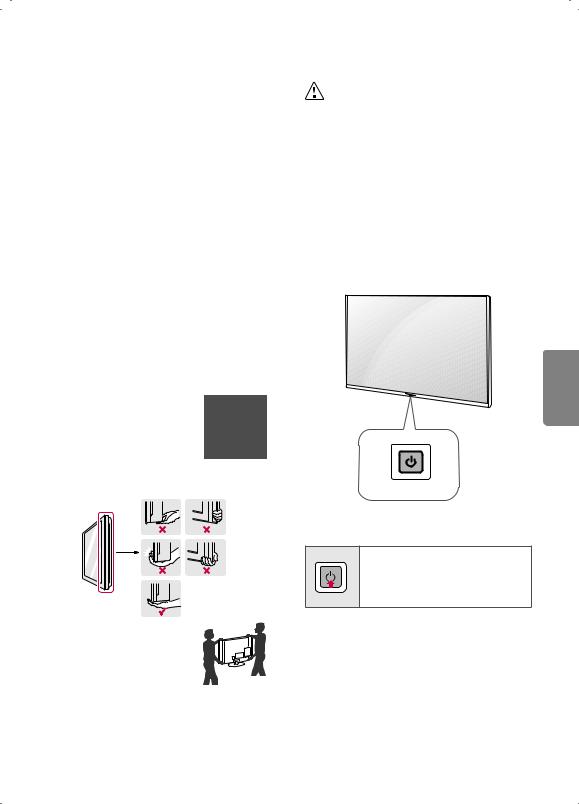
••When attaching the stand to the TV set, place the screen facing down on a cushioned table or flat surface to protect the screen from scratches. (Depending upon model)
••Make sure that the screws are fastened tightly. (If they are not fastened securely enough, the TV may tilt forward after being installed.)
••Do not fasten the screws with excessive force otherwise they may be worn out and become loose.
••Make sure to wring any excess water or cleaner from the cloth.
••Do not spray water or cleaner directly onto the TV screen.
••Make sure to spray just enough of water or cleaner onto a dry cloth to wipe the screen.
Lifting and Moving the TV
When moving or lifting the TV, read the following to prevent the TV from being scratched or damaged and for safe transportation regardless of its type and size.
••It is recommended to move the TV in the box or packing material that the TV originally came in.
••Before moving or lifting the TV, disconnect the power cord and all cables.
••When holding the TV, the screen should face away from you to avoid damage.
••Hold the top and bottom of the TV frame firmly. Make sure not to hold the transparent part, speaker, or speaker grille area.
••Use at least two people to move
a large TV.
••When transporting the TV by
hand, hold the TV as shown in the following illustration.
••When transporting the TV, do not expose the TV to jolts or excessive vibration.
••When transporting the TV, keep the TV upright; never turn the TV on its side or tilt towards the left or right.
••When handling the TV, be careful not to damage the protruding buttons.
••Avoid touching the screen at all times, as this may result in damage to the screen.
••Do not place the product on the floor with its front facing down without padding. Failure to do so may result in damage to the screen.
••Do not move the TV by holding the cable holders, as the cable holders may break, and injuries and damage to the TV may occur. (Depending upon model)
Using the Button
You can operate the TV functions, using the button.
ENGLISH
Basic Functions
Power On (Press)
Power Off 1 (Press and Hold)
Menu control (Press 2)
Menu selection (Press and Hold 3)
1All running apps will close.
2You can access and adjust the menu by pressing the button when TV is on.
3You can use the function when you access menu control.
5
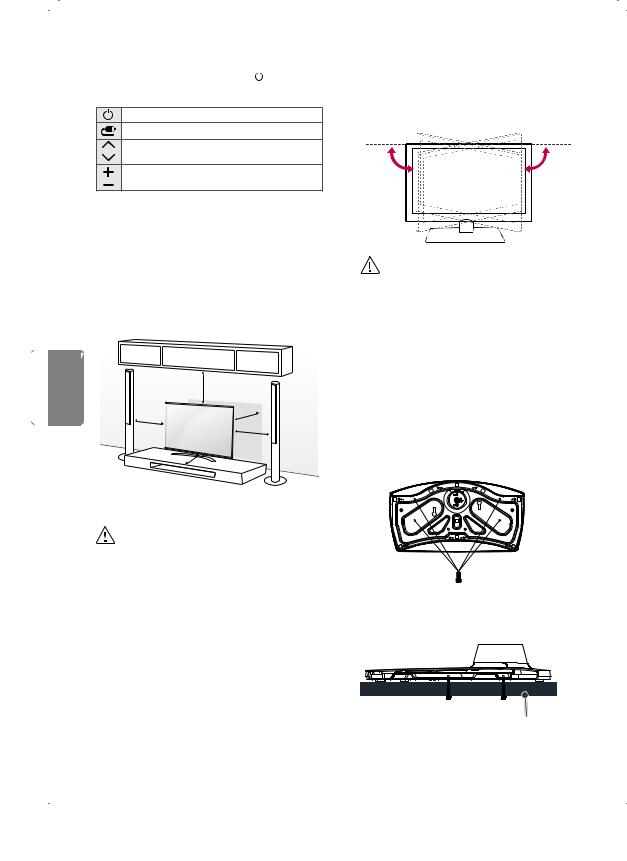
Adjusting the Menu
When the TV is turned on, press the  button one time. You can adjust the Menu items using the buttons.
button one time. You can adjust the Menu items using the buttons.
Turns the power off.
Changes the input source.
Scrolls through the saved channels.
Adjusts the volume level.
Mounting on a Table
(Depending upon model)
1Lift and tilt the TV into its upright position on a table.
-- Leave a 10 cm (4 inches) (minimum) space from the wall for proper ventilation.
ENGLISH |
|
10 cm |
cm |
|
|
(4 inches) |
|
|
10 cm |
10 |
|
|
10 cm |
||
|
|
||
|
|
10 cm |
|
2 Connect the power cord to a wall outlet.
••Do not place the TV near or on sources of heat, as this may result in fire or other damage.
••Do not apply foreign substances (oils, lubricants, etc.) to the screw parts when assembling the product. (Doing so may damage the product.)
Adjusting the Angle of the TV to Suit View
(Depending upon model)
Swivel 20 degrees to the left or right and adjust the angle of the TV to suit your view.
20˚ |
|
0˚ |
|
|
|
••When adjusting the angle of the TV, watch out for your fingers.
-- Personal injury may occur if hands or fingers are pinched. If the product is tilted too much, it may fall, causing damage or injury.
Attaching the TV to a desk (optional)
(Depending upon model)
If mounting the TV on a table, make sure it is installed according to the method outlined in ‘Attaching the TV to a desk’.
The TV should be attached to a desk so it cannot be pulled in a forward/backward direction, potentially causing injury or damaging the product.
4-Screws
(Not provided as parts of the product.)
Stand
Desk
6
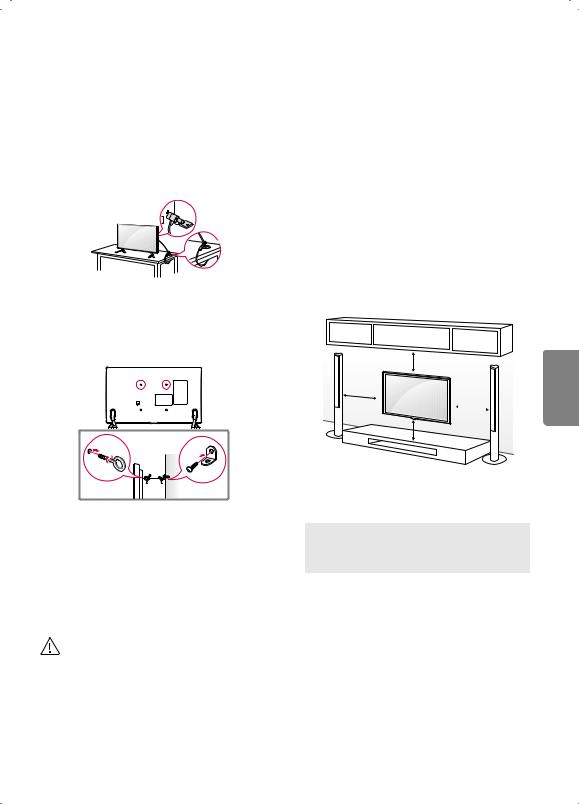
Using the kensington security system (optional)
The Kensington security system connector is located at the rear of the TV. For more information of installation and using, refer to the manual provided with the Kensington security system
or visit http://www.kensington.com. Connect the Kensington security system cable between the TV and a table.
••The Kensington security system is optional. You can obtain additional accessories from your local dealer.
Securing the TV to a Wall (optional)
(Depending upon model)
1Insert and tighten the eye-bolts or TV brackets and bolts on the back of the TV.
-- If there are bolts inserted at the eye-bolts position, remove the bolts first.
2Mount the wall brackets with the bolts to the wall. Match the location of the wall bracket and the eye-bolts on the rear of the TV.
3Connect the eye-bolts and wall brackets tightly with a sturdy rope or cable. Make sure to keep
the rope parallel to the flat surface.
••Make sure that children do not climb on or hang on the TV.
••Use a platform or cabinet that is strong and large enough to support the TV securely.
••Brackets, bolts, and ropes are optional. You can obtain additional accessories from your local dealer.
Mounting on a Wall
An optional wall mount can be used with your LG Television. Consult with your local dealer for a wall mount that supports the VESA standard used by your TV model. Carefully attach the wall
mount bracket at the rear of the TV. Install the wall mount bracket on a solid wall perpendicular to the floor. If you are attaching the TV to other building materials, please contact qualified personnel to install the wall mount. Detailed instructions will be included with the wall mount. We recommend that you use an LG brand wall mount. The LG wall mount is easy to adjust or to connect the cables. When you do not use LG’s wall mount bracket, use a wall mount bracket where the device is adequately secured to the wall with enough space to allow connectivity to external devices. If you are using a non-adjustable mount, attach the mount to the wall. Attach the cables to the TV first, then attach the TV to the mount.
|
10 cm |
ENGLISH |
|
(4 inches) |
|
|
|
|
10 cm |
10 cm |
|
|
|
|
|
10 cm |
|
Make sure to use screws and wall mounts that meet the VESA standard. Standard dimensions for the wall mount kits are described in the following table.
|
|
49UV340C |
|
Model |
43UV340C |
49UV340H |
|
43UV340H |
55UV340C |
||
|
|||
|
|
55UV340H |
|
VESA (A x B) |
200 x 200 |
300 x 300 |
|
Standard screw |
M6 |
M6 |
|
Number of screws |
4 |
4 |
|
Wall mount bracket |
LSW240B |
LSW350B |
|
(optional) |
MSW240 |
MSW240 |
7
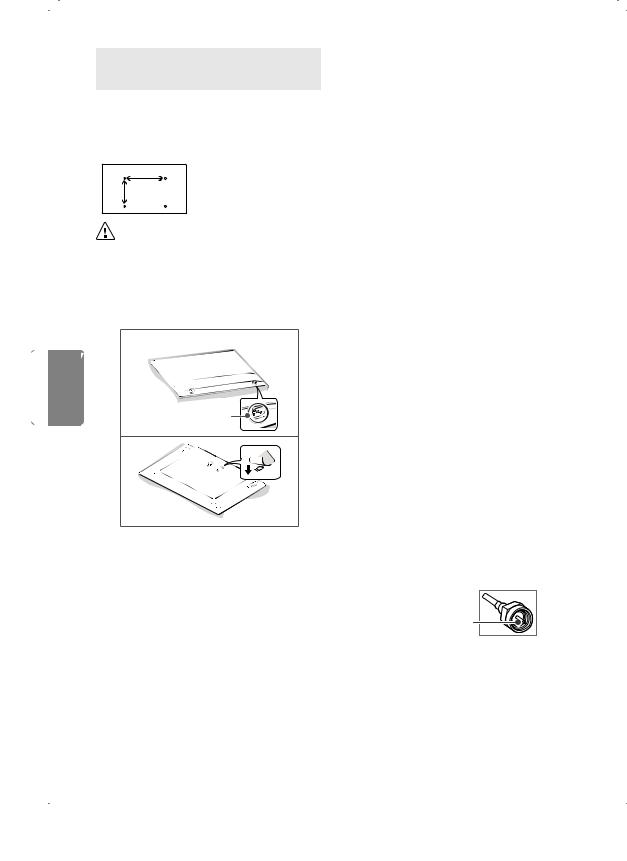
Model |
65UV340C |
75UV340C |
|
65UV340H |
|||
|
|
||
|
|
|
|
VESA (A x B) |
300 x 300 |
600 x 400 |
|
Standard screw |
M6 |
M8 |
|
Number of screws |
4 |
4 |
|
Wall mount bracket |
LSW350B |
LSW640B |
|
(optional) |
|||
|
|
A
B
••Remove the stand before installing the TV on a wall mount by performing the stand attachment in reverse.
••When using the wall mount, it is recommended that you apply a piece of tape over the Stand holes to prevent dust and bugs from entering the holes. (Depending upon model)
ENGLISH |
Stand Hole |
|
8
Connections (Notifications)
You can connect various external devices to the TV. Supported external devices are: HD receivers, DVD players, VCRs, audio systems, USB storage devices, PC, gaming devices, and other external devices. For more information on external device’s connection, refer to the manual provided with each device.
••If you record a TV program on a DVD recorder or
VCR, make sure to connect the TV signal input cable to the TV through a DVD recorder or VCR. For more information about recording, refer to the manual provided with the connected device.
••The external device connections shown may differ slightly from illustrations in a manual.
••Connect external devices to the TV regardless about the order of the TV port.
••If you connect a gaming device to the TV, use the cable supplied with the gaming device.
••Refer to the external equipment’s manual for operating instructions.
••In PC mode, there may be noise associated with the resolution, vertical pattern, contrast or brightness. If noise is present, change the PC
output to another resolution, change the refresh rate to another rate or adjust the brightness and contrast on the Picture menu until the picture is clear. Depending upon the graphics card, some resolution settings may not allow the image to be positioned on the screen properly.
••Some USB Hubs may not work. If a USB device connected through a USB Hub is not detected, connect it directly to the USB port on the TV.
••When connecting via a wired LAN, it is recommended to use a CAT 7 cable.
Connecting to an Antenna or Cable
Connect an antenna, cable, or cable box to watch TV while referring to the following. The illustrations may differ from the actual items and an RF cable is optional.
••Make sure not to bend the copper wire of the RF cable.
Copper wire
••Complete all connections between devices, and then connect the power cord to the power outlet to prevent damage to your TV.
••Use a signal splitter to use 2 TVs or more.
••DTV Audio Supported Codec: MPEG, Dolby Digital
••This TV cannot receive ULTRA HD (3840 x 2160 pixels) broadcasts directly because the related standards have not been confirmed. (Depending upon model)
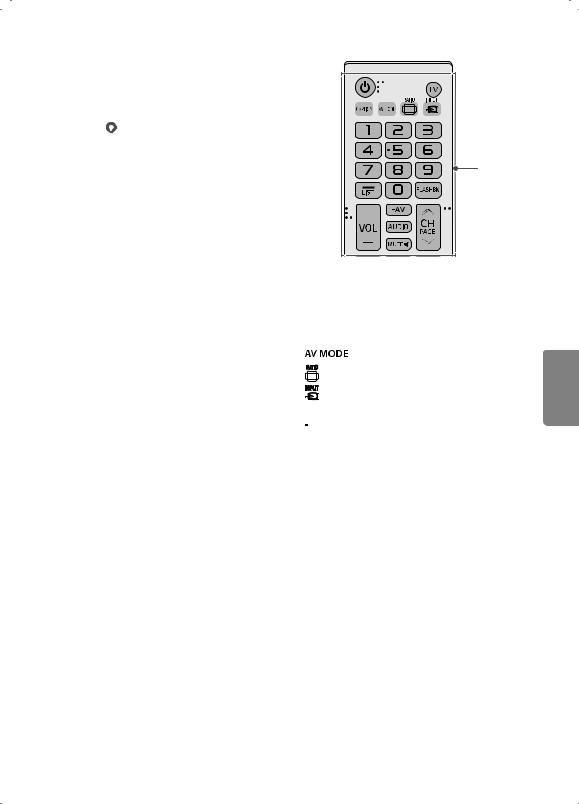
Other Connections
Connect your TV to external devices. For the best picture and audio quality, connect the external device and the TV with the HDMI cable.
• >
> > General > HDMI ULTRA HD Deep Color:
> General > HDMI ULTRA HD Deep Color:
-- On : Support 4K @ 60 Hz (4:4:4, 4:2:2, 4:2:0) -- Off : Support 4K @ 60 Hz 8bit (4:2:0)
••If the device connected to Input Port also supports ULTRA HD Deep Color, your picture may be clearer. However, if the device doesn’t support it, it may not work properly. In that case, connect the device to a different HDMI port or change the TV’s HDMI ULTRA HD Deep Color setting to off.
••HDMI Audio Supported Format: DTS (44.1 kHz / 48 kHz), Dolby Digital / Dolby Digital Plus (32 kHz / 44.1 kHz / 48 kHz), PCM (32 kHz / 44.1 kHz / 48 kHz / 96 kHz / 192 kHz) (Depending upon model)
••Use only with the 3 pole 3.5 mm stereo jack.
••Do not connect your headphones or earphones to the port for connecting an external speaker.
Remote Control
(Some buttons and services may not be provided depending upon models or regions.)
The descriptions in this manual are based on the buttons on the remote control. Please read this manual carefully and use the TV correctly. To install batteries, open the battery cover, replace
batteries (1.5 V AAA) matching the  and
and  ends to the label inside the compartment, and close the battery cover. Failure to match the correct polarities of the batteries may cause the battery to burst or leak, resulting in fire, personal injury, or ambient pollution. To remove the batteries, perform the installation actions in reverse. This remote uses infrared light. When in use, it should be pointed in the direction of the TV’s remote sensor.
ends to the label inside the compartment, and close the battery cover. Failure to match the correct polarities of the batteries may cause the battery to burst or leak, resulting in fire, personal injury, or ambient pollution. To remove the batteries, perform the installation actions in reverse. This remote uses infrared light. When in use, it should be pointed in the direction of the TV’s remote sensor.
A
A
 (Power) Turns the TV on or off.
(Power) Turns the TV on or off.
 Returns to the last TV channel.
Returns to the last TV channel.
 Activates or deactivates the subtitles.
Activates or deactivates the subtitles.
Not functional. |
ENGLISH |
Number button Enters numbers. |
|
Resizes an image. |
|
Changes the input source. |
|
(Dash) Inserts a dash between numbers such as |
|
2-1 and 2-2. |
|


 Accesses the saved channel list.
Accesses the saved channel list.
 Alternates between the two last channels selected (pressing repeatedly).
Alternates between the two last channels selected (pressing repeatedly).


 Adjusts the volume level.
Adjusts the volume level.
 Accesses your favorite channel list.
Accesses your favorite channel list.
 Digital signal: Changes the audio language. Analog signal: Changes the MTS sound.
Digital signal: Changes the audio language. Analog signal: Changes the MTS sound.

 Mutes all sounds.
Mutes all sounds.
••Pressing and holding the 
 button displays the Accessibility menu.
button displays the Accessibility menu.


 Scrolls through the saved channels.
Scrolls through the saved channels. 

 Moves to the previous or next screen
Moves to the previous or next screen
9
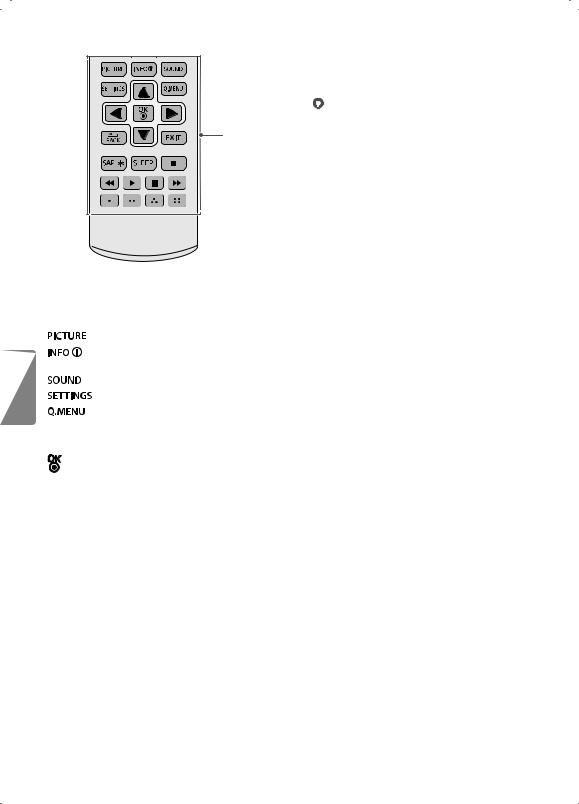
B
B
|
|
Changes the picture mode. |
|
|
Shows information on the current |
ENGLISH |
|
|
|
program. |
|
|
Changes the sound mode. |
|
|
|
|
|
|
Accesses the setting menu. |
|
|
Accesses the quick menu. |
|
|
Navigation button (up / down / left / right) |
|
|
|
|
|
Scrolls through menus or options. |
|
|
Selects menus or options and confirms your |
|
|
input. |

 Returns to the previous screen.
Returns to the previous screen.
 Clears all on-screen displays and returns to TV viewing.
Clears all on-screen displays and returns to TV viewing.
 Enables SAP (Secondary Audio Program) Feature.
Enables SAP (Secondary Audio Program) Feature.
 Sets the length of time until the TV to turns
Sets the length of time until the TV to turns

 ,
,  ,
,  ,
,  Control buttons for media contents
Control buttons for media contents



 These access special functions in some menus.
These access special functions in some menus.
Settings
To select Picture Mode
 •Picture •Picture Mode Settings • Picture
•Picture •Picture Mode Settings • Picture
Mode
Select the picture mode optimized for the viewing environment or the program.
••Vivid Heightens contrast, brightness, and sharpness to display vivid images.
••Standard Displays images in standard levels of contrast, brightness and sharpness.
••APS APS (Auto power saving) mode reduces power consumption by dimming control.
••Cinema / Game Displays the optimum picture for movie or game.
••Sports Optimised picture mode for football matches. The pitch and kits are presented in vibrant colours, with crystal-clear images even for fast movements.
••HDR Effect This feature lets you enjoy a more dynamic, clearer image by correcting the light and dark areas of the display. This feature provides a realistic image, even when the source image’s gradation level is high. If you set Picture Mode to HDR Effect, you will not be able to use some of Picture Mode Settings.
••Expert Menu for adjusting picture quality that allows experts and amateurs to enjoy the best TV viewing. This menu for adjustment is provided for ISF-certified picture tuning professionals. (ISF logo can be used only on ISF-certified TVs.) ISFccc: Imaging Science Foundation Certified Calibration Control
••Depending upon the input signal, the available range of picture modes may differ.
••Expert mode is for picture tuning professionals to control and fine-tune using a specific image. For normal images, the effects may not be drastic.
••Picture Mode change may modify Energy Saving and Motion Eye Care settings and it can affect energy consumption.
10
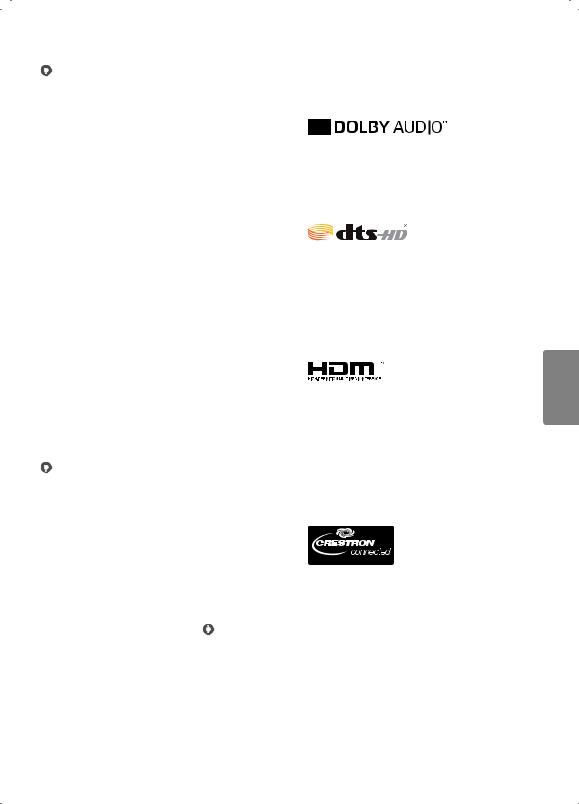
To set additional picture options
 •Picture •Picture Mode Settings •Picture
•Picture •Picture Mode Settings •Picture
Options
Adjusts detailed setting for images.
••Noise Reduction Eliminates noise in the picture.
••MPEG Noise Reduction Eliminates noise generated while creating digital picture signals.
••Black Level Adjusts the brightness and contrast of the screen to suit the black level.
••Real Cinema Optimizes the screen for movie viewing.
••Motion Eye Care Automatically adjusts brightness and reduces image blur based on image data to reduce eyestrain.
••LED Local Dimming
Maximizes the contrast ratio by making the bright areas of the screen brighter and the dark areas of the screen darker.
-- Off : Disables the LED Local Dimming function. -- Low / Medium / High : Changes the contrast
ratio.
Turning this option Off may increase energy consumption.
••TruMotion Corrects images to display smoother motion sequences. Auto means juddering and blurring range that depend on input video status is controlled by TruMotion mode.
••Depending upon input signal or other picture settings, the range of detailed items for adjustment may differ.
To use energy saving feature
 • Picture •Energy Saving
• Picture •Energy Saving
Reduces power consumption by adjusting peak screen brightness.
••Auto The TV sensor detects the ambient lighting and automatically adjusts the screen brightness.
••Off Turns off the Energy Saving.
••Minimum / Medium / Maximum Applies the pre-set Energy Saving.
••Screen Off Screen is turned off and only sound is played. Press any button on the remote control to turn the screen back on.
••Depending on the Energy Saving (Auto / Maximum), you may not be able to adjust the Backlight. In this case, navigate to  •Picture
•Picture
•Energy Saving and set to Off or Minimum.
Licenses
Supported licenses may differ by model. For more information about licenses, visit www.lg.com.
Manufactured under license from Dolby Laboratories. Dolby, Dolby Vision, Dolby Audio, and the double-D symbol are trademarks of Dolby Laboratories.
For DTS patents, see http://patents.dts.com.
Manufactured under license from DTS Licensing Limited.
DTS, DTS-HD, the Symbol, & DTS or DTS-HD and the Symbol together are registered trademarks of DTS, Inc. © DTS, Inc. All Rights Reserved.
|
ENGLISH |
||
|
|
|
|
The terms HDMI and HDMI High-Definition |
|||
Multimedia Interface, and the HDMI logo are |
|
||
|
|||
trademarks or registered trademarks of HDMI |
|
||
Licensing LLC in the United States and other |
|
||
countries. |
|
||
(Depending upon model)
11

Open Source Software Notice
Information
To obtain the source code under GPL, LGPL, MPL, and other open source licenses, that is contained in this product, please visit http://opensource.lge.com.
In addition to the source code, all referred license terms, warranty disclaimers and copyright notices are available for download.
LG Electronics will also provide open source code to you on CD-ROM for a charge covering the cost of performing such distribution (such as the cost of media, shipping, and handling) upon email request to opensource@lge.com. This offer is valid for three
(3) years from the date on which you purchased the product.
Troubleshooting
|
|
The software may be updated for improvement |
|
|
in performance. The customer is responsible to |
|
|
ensure the compatibility of their equipment with |
|
|
|
ENGLISH |
|
any LG Electronics software. If needed, please |
|
consult with LG Electronics and update new |
|
|
|
|
|
|
software versions according to the guidance |
|
|
provided by LG Electronics. |
|
|
••Cannot control the TV with the remote control. |
|
|
-- Check if anything such as tape has been placed |
|
|
|
|
|
over the receiver. |
|
|
-- Check if there is any obstacle between the |
|
|
product and the remote control. |
|
|
-- Replace the batteries with new fresh ones. |
|
|
••No image display and no sound is produced. |
|
|
-- Check if the product is turned on. |
|
|
-- Check if the power cord is connected to a wall |
|
|
outlet. |
|
|
-- Check if there is a problem in the wall outlet by |
|
|
connecting other products. |
|
|
••The TV turns off suddenly. |
|
|
-- Check the power control settings. |
|
|
-- The power supply may be interrupted. |
|
|
-- Check if the Timer Power Off / Sleep Timer |
|
|
feature is activated in the Timers settings. |
|
|
-- If there is no signal while the TV is on, the TV |
|
|
will turn off automatically after 15 minutes of |
|
|
inactivity. |
••Abnormal Display
-- If the TV feels cold to the touch, there may be a small flicker when it is turned on. This is normal; there is nothing wrong with TV. Some minute dot defects may be visible on the screen, appearing as tiny red, green, or blue
spots. However, they have no adverse effect on the TV’s performance. Avoid touching the LCD screen or holding your finger(s) against it for long periods of time. Doing so may produce some temporary distortion effects on the screen.
-- This panel is an advanced product that contains millions of pixels. In a very few cases, you could see fine dots on the screen while you’re viewing the TV. Those dots are deactivated pixels and do not affect the performance and reliability
of the TV.
-- Displaying a still image for a prolonged period of time may cause an image sticking. Avoid displaying a fixed image on the TV screen for a extended length of time.
••Generated Sound
-- Cracking noise A cracking noise that occurs when watching or turning off the TV is generated by plastic thermal contraction due to temperature and humidity. This noise is common for products where thermal deformation is required.
-- Electrical circuit humming/panel buzzing
A low level noise is generated from a highspeed switching circuit, which supplies a large amount of current to operate a product. It varies depending upon the product.
This generated sound does not affect the performance and reliability of the product.
12

Specifications
Product specifications may be changed without prior notice due to upgrade of product functions.
Estimated yearly energy consumption indicated on the FTC label is measured in accordance with the Test Procedures for Television Sets (USA only).
The actual energy consumption depends on the usage environment (The content watched, TV settings, etc.).
Television System
ATSC, NTSC-M, 64 & 256 QAM
Program Coverage
VHF 2-13, UHF 14-69, DTV 2-69, CATV 1-135, CADTV 1-135
External Antenna Impedance
75 Ω
Environment condition
••Operating Temperature
0 °C to 40 °C (32 °F to 104 °F)
••Operating Humidity
Less than 80 %
••Storage Temperature
-20 °C to 60 °C (-4 °F to 140 °F)
••Storage Humidity
Less than 85 %
HDMI (PC) supported mode
Resolution |
Horizontal |
Vertical |
|
Frequency (kHz) |
Frequency (Hz) |
||
|
|||
640 x 350 |
31.46 |
70.09 |
|
720 x 400 |
31.46 |
70.08 |
|
640 x 480 |
31.46 |
59.94 |
|
800 x 600 |
37.87 |
60.31 |
|
1024 x 768 |
48.36 |
60.00 |
|
1360 x 768 |
47.71 |
60.01 |
|
1152 x 864 |
54.34 |
60.05 |
|
1280 x 1024 |
63.98 |
60.02 |
|
1920 x 1080 |
67.50 |
60.00 |
|
135.00 |
120.00 |
||
|
|||
|
54.00 |
24.00 |
|
3840 x 2160 |
56.25 |
25.00 |
|
|
67.50 |
30.00 |
|
4096 x 2160 |
53.95 |
23.97 |
|
54.00 |
24.00 |
||
|
HDMI (DTV) supported mode
Resolution |
Horizontal |
Vertical |
|
Frequency (kHz) |
Frequency (Hz) |
||
|
|||
640 x 480p |
31.46 |
59.94 |
|
31.50 |
60.00 |
||
|
|||
720 x 480p |
31.47 |
59.94 |
|
31.50 |
60.00 |
||
|
|||
720 x 480i |
15.75 |
60.00 |
|
720 x 576p |
31.25 |
50.00 |
|
720 x 576i |
15.62 |
50.00 |
|
|
37.50 |
50.00 |
|
1280 x 720p |
44.96 |
59.94 |
|
|
45.00 |
60.00 |
|
|
28.12 |
50.00 |
|
1920 x 1080i |
33.72 |
59.94 |
|
|
33.75 |
60.00 |
|
|
26.97 |
23.97 |
|
|
27.00 |
24.00 |
|
|
33.71 |
29.97 |
|
|
33.75 |
30.00 |
|
1920 x 1080p |
56.25 |
50.00 |
|
|
67.43 |
59.94 |
|
|
67.50 |
60.00 |
|
|
112.50 |
100.00 |
|
|
134.86 |
119.88 |
|
|
135.00 |
120.00 |
|
|
53.95 |
23.98 |
|
|
54.00 |
24.00 |
|
|
56.25 |
25.00 |
|
3840 x 2160p |
61.43 |
29.97 |
|
|
67.50 |
30.00 |
|
|
112.50 |
50.00 |
|
|
134.86 |
59.94 |
|
|
135.00 |
60.00 |
|
|
53.95 |
23.98 |
|
|
54.00 |
24.00 |
|
|
56.25 |
25.00 |
|
4096 x 2160p |
61.43 |
29.97 |
|
|
67.50 |
30.00 |
|
|
112.50 |
50.00 |
|
|
134.86 |
59.94 |
|
|
135.00 |
60.00 |
••The optimal display resolution -- 3840 X 2160
ENGLISH
13

Component port connecting information
(Depending upon model)
Component ports on the TV |
Y |
PB |
PR |
|
|
|
|
|
|
|
Y |
PB |
PR |
|
Video output ports on DVD player |
Y |
B-Y |
R-Y |
|
Y |
Cb |
Cr |
||
|
||||
|
Y |
Pb |
Pr |
Component supported mode
|
|
Resolution |
Horizontal |
Vertical |
|
|
Frequency (kHz) |
Frequency (Hz) |
|
|
|
|
||
|
|
720 x 480i |
15.73 |
59.94 |
|
|
15.75 |
60.00 |
|
|
|
|
||
|
|
720 x 576i |
15.62 |
50.00 |
|
|
720 x 480p |
31.47 |
59.94 |
|
|
31.50 |
60.00 |
|
|
|
|
||
|
|
720 x 576p |
31.25 |
50.00 |
|
|
|
44.96 |
59.94 |
|
|
1280 x 720p |
45.00 |
60.00 |
|
|
|
37.50 |
50.00 |
|
|
|
||
ENGLISH |
|
|
28.12 |
50.00 |
|
|
1920 x 1080i |
33.72 |
59.94 |
|
|
|
33.75 |
60.00 |
|
|
|
56.25 |
50 |
|
|
1920 x 1080p |
67.43 |
59.94 |
|
|
|
67.50 |
60.00 |
Supported Photo Formats
File Format |
Format |
Resolution |
|
|
|
Minimum: 64 x 64, |
|
.jpeg, .jpg, |
|
Maximum: Normal Type: |
|
JPEG |
15,360 (W) x 8,640 (H), |
||
.jpe |
|||
|
Progressive Type: |
||
|
|
||
|
|
1,920 (W) x 1,440 (H) |
|
|
|
Minimum: 64 x 64, |
|
.png |
PNG |
Maximum: |
|
|
|
5,760 (W) x 5,760 (H) |
|
|
|
Minimum: 64 x 64, |
|
.bmp |
BMP |
Maximum: |
|
|
|
1,920 (W) x 1,080 (H) |
14
Supported Audio Formats
File Format |
Info |
[Bit rate] 32 Kbps ~ 320 Kbps
.mp3 [Sample freq.] 16 kHz ~ 48 kHz [Support] MPEG-1, MPEG-2
[Channels] mono, stereo
[Bit rate] Free Format
.wav [Sample freq.] 8 kHz ~ 96 kHz [Support] PCM
[Channels] mono, stereo
[Bit rate] 64 Kbps ~ 320 Kbps
.ogg [Sample freq.] 8 kHz ~ 48 kHz [Support] Vorbis
[Channels] mono, stereo
[Bit rate] 128 Kbps ~ 320 Kbps
.wma [Sample freq.] 8 kHz ~ 48 kHz [Support] WMA
[Channels] up to 6 ch
[Bit rate] Free Format
.flac [Sample freq.] 8 kHz ~ 96 kHz [Support] FLAC
[Channels] mono, stereo
Supported Video Formats
Extension |
|
Codec |
|
|
|
VC-1 Advanced Profile |
|
|
Video |
(Except for WMVA), VC-1 |
|
.asf, .wmv |
|
Simple and Main Profiles |
|
|
Audio |
WMA Standard (except for |
|
|
WMA v1/ WMA Speech) |
||
|
|
Xvid (except for 3 warp-point |
|
|
Video |
GMC), H.264/AVC, Motion |
|
.avi |
|
Jpeg, MPEG-4 |
|
|
MPEG-1 Layer I, II, MPEG-1 |
||
|
|
||
|
Audio |
Layer III (MP3), Dolby Digital, |
|
|
|
LPCM, ADPCM, DTS |
|
.mp4, |
Video |
H.264/AVC, MPEG-4, HEVC |
|
|
|
||
.m4v, |
|
Dolby Digital, Dolby Digital |
|
.mov |
Audio |
Plus, AAC, MPEG-1 Layer III |
|
|
|
(MP3) |
|
.3gp, .3g2 |
Video |
H.264/AVC, MPEG-4 |
|
Audio |
AAC, AMR-NB, AMR-WB |
||
|
|||
|
Video |
MPEG-2, MPEG-4, H.264/AVC, |
|
|
VP8, VP9, HEVC |
||
.mkv |
|
Dolby Digital, Dolby Digital |
|
|
Plus, AAC, PCM, DTS, MPEG-1 |
||
|
Audio |
||
|
Layer I, II, MPEG-1 Layer III |
||
|
|
(MP3) |
|
.ts, .trp, |
Video |
H.264/AVC, MPEG-2, HEVC |
|
|
MPEG-1 Layer I, II, MPEG-1 |
||
.tp, .mts |
Audio |
Layer III (MP3), Dolby Digital, |
|
|
|
Dolby Digital Plus, AAC, PCM |
|
.mpg, |
Video |
MPEG-1, MPEG-2 |
|
.mpeg, |
Audio |
MPEG-1 Layer I, II, MPEG-1 |
|
.dat |
Layer III (MP3) |

|
Video |
MPEG-1, MPEG-2 |
|
.vob |
Audio |
Dolby Digital, MPEG-1 Layer I, |
|
|
II, DVD-LPCM |
||
|
Video |
RV30, RV40 |
|
.rm, .rmvb |
Audio |
Realaudio6 (cook), AAC LC, |
|
|
HE-AAC |
||
.mkv, |
Video |
H.264/AVC, HEVC |
|
Audio |
Dolby Digital, Dolby Digital |
||
.mp4, .ts |
|||
|
|
Plus, AAC |
Regulatory
FCC NOTICE
(For USA)
This equipment has been tested and found to comply with the limits for a Class B digital device, pursuant to Part 15 of the FCC Rules. These limits are designed to provide reasonable protection against harmful interference in a residential installation. This equipment generates, uses
and can radiate radio frequency energy and, if not installed and used in accordance with the instructions, may cause harmful interference to radio communications. However, there is no guarantee that interference will not occur in a particular installation. If this equipment does
cause harmful interference to radio or television reception, which can be determined by turning the equipment off and on, the user is encouraged to try to correct the interference by one or more of the following measures:
-- Reorient or relocate the receiving antenna. -- Increase the separation between the
equipment and the receiver.
-- Connect the equipment to an outlet on a circuit different from that to which the receiver is connected.
-- Consult the dealer or an experienced radio/TV technician for help.
This device complies with part 15 of the FCC Rules. Operation is subject to the following two conditions: (1) this device may not cause harmful interference and (2) this device must accept any interference received, including interference that may cause undesired operation of the device. Any changes or modifications in construction of this device which are not expressly approved by the party responsible for compliance could void the user’s authority to operate the equipment.
FCC Radio Frequency Interference Requirements (for UNII devices)
High power radars are allocated as primary users of the 5.25 to 5.35 GHz and 5.65 to 5.85 GHz bands. These radar stations can cause interference with and/or damage this device. This device cannot be co-located with any other transmitter.
FCC RF Radiation Exposure Statement
[For having wireless function (WLAN, Bluetooth,...)]
This equipment complies with FCC radiation exposure limits set forth for an uncontrolled environment. This transmitter must not be colocated or operating in conjunction with any other antenna or transmitter. This equipment should be installed and operated with minimum distance 20 cm (7.8 inches) between the radiator and your body. Users must follow the specific operating instructions for satisfying RF exposure compliance.
Industry Canada Statement
(For Canada)
[For having wireless function (WLAN, Bluetooth,...)]
This device complies with Industry Canada’s applicable licence-exempt RSSs. Operation is subject to the following two conditions:
(1)This device may not cause interference; and
(2)This device must accept any interference, including interference that may cause undesired operation of the device.
ENGLISH
15
